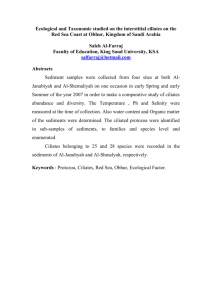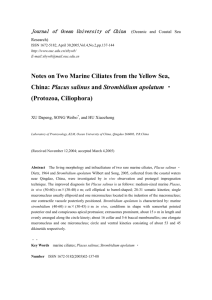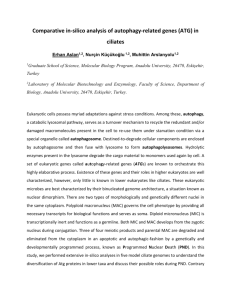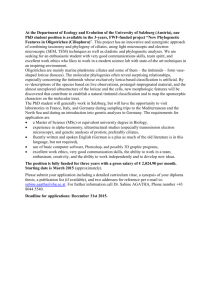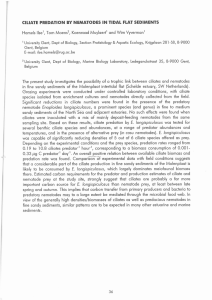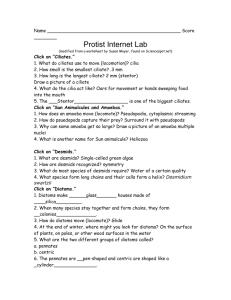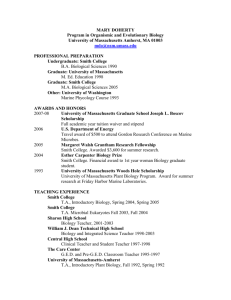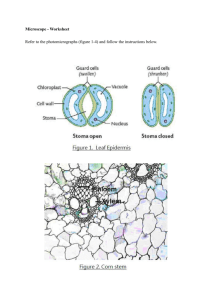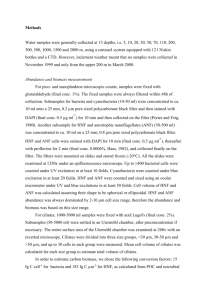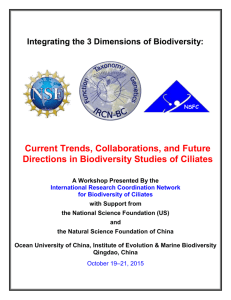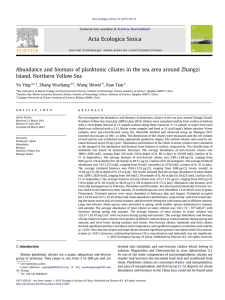XVIII. The Ciliophora (Chapter 10) 2011 A. Characteristics
advertisement
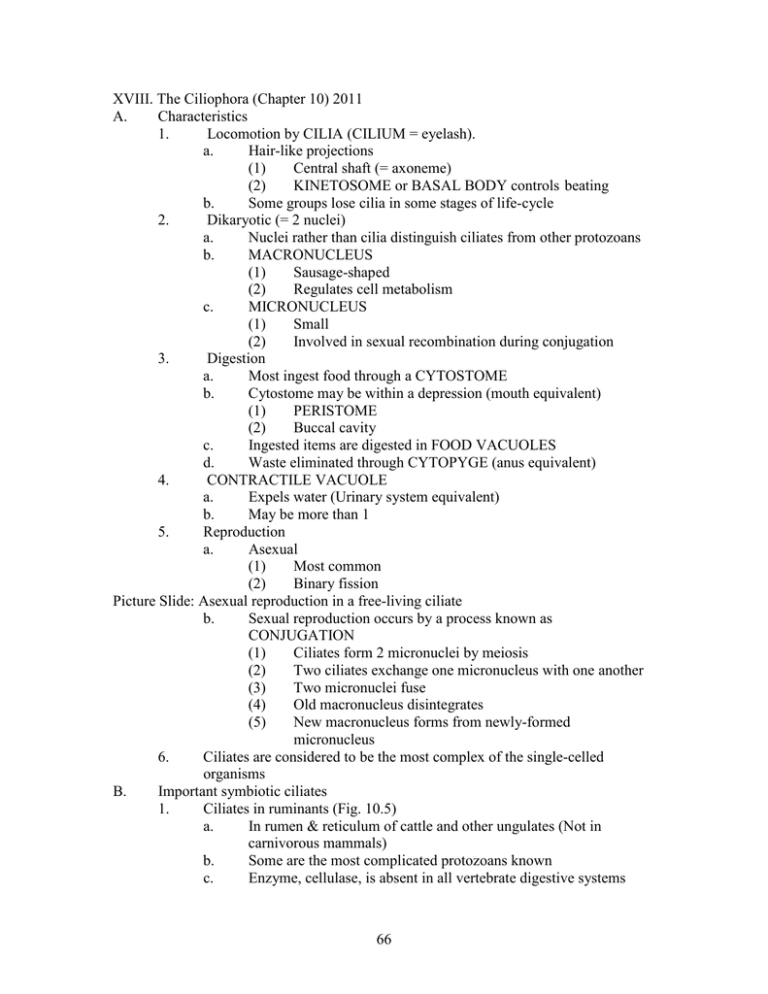
XVIII. The Ciliophora (Chapter 10) 2011 A. Characteristics 1. Locomotion by CILIA (CILIUM = eyelash). a. Hair-like projections (1) Central shaft (= axoneme) (2) KINETOSOME or BASAL BODY controls beating b. Some groups lose cilia in some stages of life-cycle 2. Dikaryotic (= 2 nuclei) a. Nuclei rather than cilia distinguish ciliates from other protozoans b. MACRONUCLEUS (1) Sausage-shaped (2) Regulates cell metabolism c. MICRONUCLEUS (1) Small (2) Involved in sexual recombination during conjugation 3. Digestion a. Most ingest food through a CYTOSTOME b. Cytostome may be within a depression (mouth equivalent) (1) PERISTOME (2) Buccal cavity c. Ingested items are digested in FOOD VACUOLES d. Waste eliminated through CYTOPYGE (anus equivalent) 4. CONTRACTILE VACUOLE a. Expels water (Urinary system equivalent) b. May be more than 1 5. Reproduction a. Asexual (1) Most common (2) Binary fission Picture Slide: Asexual reproduction in a free-living ciliate b. Sexual reproduction occurs by a process known as CONJUGATION (1) Ciliates form 2 micronuclei by meiosis (2) Two ciliates exchange one micronucleus with one another (3) Two micronuclei fuse (4) Old macronucleus disintegrates (5) New macronucleus forms from newly-formed micronucleus 6. Ciliates are considered to be the most complex of the single-celled organisms B. Important symbiotic ciliates 1. Ciliates in ruminants (Fig. 10.5) a. In rumen & reticulum of cattle and other ungulates (Not in carnivorous mammals) b. Some are the most complicated protozoans known c. Enzyme, cellulase, is absent in all vertebrate digestive systems 66 d. Participate in digestion (= fermentation) of cellulose (1) Role NOT essential to host survival (2) Fermentation of cellulose will continue to be performed by symbiotic bacteria (3) Defaunated ruminates do NOT grow as fast untreated controls Picture Slide: The Ruminant Stomach; Four specialized compartments enable ruminants to digest and subsist on protein-poor plant material; Purves, et al., 2001, Life The Science of Biology, 6th ed., W.H. Freeman & Co., p. 902 Picture Slide: Ruminant Ciliate Symbionts; Fig. 10.5, p. 177 2. Balantidium coli (pp 176-77) a. World-wide distribution b. Only ciliate parasitic in humans c. Pigs may be a more ancient host d. BALANTIDIASIS (1) Pathogenic (2) As with amebic dysentery, cells invade mucosal layer of large intestine causing ulcers Picture Slides: Balantidium coli trophozoite; http://www.soton.ac.uk/~ceb/Diagnosis/Vol2.htm (3) Ciliates secrete enzyme HYALURONIDASE which breaks down extracellular matrix of connective tissue (4) Often associated with the whipworm, Trichiuris trichiura Data Slide: Outbreak of Balantidiasis following a Typhoon on the Island of Truk; It is thought that pig feces contaminated the drinking water following the typhoon; Smyth, J.D, 1994, Introduction Animal Parasitology, 3th ed., Cambridge Univ. Press, p. 151 3. Ichthyophthirius coli (Figs. 10-6 & 10.7, pp 179-180) a. “Ich” b. Commonly infect freshwater fish in aquaria c. Will kill fish by interfering with osmoregulation and gill function Picture Slide: Life-cycle of the ciliate, Ichthyophthirius; Smyth, J.D, 1994, Introduction Animal Parasitology, 3th ed., Cambridge Univ. Press, p. 150 Data Slide: Effect of temperature on asexual reproduction of Ichthyophthiriu; Smyth, J.D, 1994, Introduction Animal Parasitology, 3th ed., Cambridge Univ. Press, p. 150. 4. Ciliates on crustaceans a. Some species located ON host (1) Form LORICA (i.e. house) (2) Catch excess food of host and/or small plankton b. Other species located IN exoskeleton (1) Burrow into exoskeleton (2) Consume inner layer of exoskeleton (Evolutionary transition stage between ecto- & endo- parasite? Picture Slide: Leg of grass shrimp showing heavy ciliate infestation in the exoskeleton; Overstreet, 1978, Marine Maladies? MASGP-78-021 67 Picture Slide: The ciliate, Lagenoprys, is found in the exoskeleton of grass shrimp and feeds on phytoplankton and scraps of host food; Overstreet, 1978, Marine Maladies? MASGP-78-021 68
